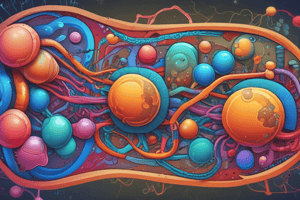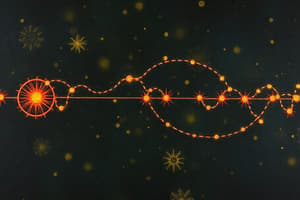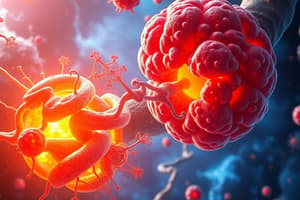Podcast
Questions and Answers
Which stage of cellular respiration produces the most ATP?
Which stage of cellular respiration produces the most ATP?
- Oxidative Phosphorylation (correct)
- Fermentation
- Citric Acid Cycle
- Glycolysis
Proton gradient is generated during glycolysis.
Proton gradient is generated during glycolysis.
False (B)
What is the primary function of ATP synthase?
What is the primary function of ATP synthase?
To synthesize ATP from ADP and inorganic phosphate.
Oxidative phosphorylation occurs in the ________ of the mitochondria.
Oxidative phosphorylation occurs in the ________ of the mitochondria.
Match the following components with their role in oxidative phosphorylation:
Match the following components with their role in oxidative phosphorylation:
What is the approximate yield of ATP from one glucose molecule during oxidative phosphorylation?
What is the approximate yield of ATP from one glucose molecule during oxidative phosphorylation?
The electron transport chain directly produces ATP.
The electron transport chain directly produces ATP.
Name one type of food source that can be used in cellular respiration.
Name one type of food source that can be used in cellular respiration.
The spinning mechanism of ATP synthase is driven by the movement of ________ back into the mitochondrial matrix.
The spinning mechanism of ATP synthase is driven by the movement of ________ back into the mitochondrial matrix.
Which of the following is NOT a component of the electron transport chain?
Which of the following is NOT a component of the electron transport chain?
Flashcards
What is Oxidative Phosphorylation?
What is Oxidative Phosphorylation?
The third and final stage of cellular respiration, occurring in the mitochondria, where most ATP is generated from the breakdown of glucose.
What is the Electron Transport Chain?
What is the Electron Transport Chain?
A series of protein complexes embedded in the inner mitochondrial membrane, where electrons from NADH and FADH2 are passed down, releasing energy.
What is the Proton Gradient?
What is the Proton Gradient?
The movement of protons across the inner mitochondrial membrane, creating a gradient that stores potential energy.
What is Chemiosmosis?
What is Chemiosmosis?
Signup and view all the flashcards
What is ATP Synthase?
What is ATP Synthase?
Signup and view all the flashcards
What is ATP Production in Oxidative Phosphorylation?
What is ATP Production in Oxidative Phosphorylation?
Signup and view all the flashcards
What is the function of Mitochondria?
What is the function of Mitochondria?
Signup and view all the flashcards
How is ATP generated from glucose?
How is ATP generated from glucose?
Signup and view all the flashcards
What is the role of electron transport in ATP synthesis?
What is the role of electron transport in ATP synthesis?
Signup and view all the flashcards
How much ATP is generated by Oxidative Phosphorylation?
How much ATP is generated by Oxidative Phosphorylation?
Signup and view all the flashcards
Study Notes
Oxidative Phosphorylation
- The third and most energy-producing stage of cellular respiration after glycolysis and the citric acid cycle.
- Utilizes the NADH and FADH2 produced in the citric acid cycle.
- Occurs in the mitochondria, specifically the inner mitochondrial membrane.
Electron Transport Chain
- A series of protein complexes (I-IV) embedded in the inner mitochondrial membrane.
- Each complex contains non-protein components called prosthetic groups, like flavin mononucleotides and cytochromes.
- Ubiquinone (Coenzyme Q) is a small, hydrophobic molecule that moves within the membrane and participates in electron transport.
- Electrons from NADH are passed through the chain, moving from one component to another with increasing electron affinity.
- This process does not directly produce ATP, but a proton gradient is generated across the membrane.
Proton Gradient and Chemiosmosis
- Protons accumulate in the intermembrane space, creating a proton gradient.
- The gradient represents stored energy called the proton-motive force.
- Protons move back into the mitochondrial matrix through a protein complex called ATP synthase.
- This movement of protons is called chemiosmosis and powers the phosphorylation of ADP to ATP.
ATP Synthase
- A protein complex that synthesizes ATP.
- Contains a rotor-like component that spins as protons bind.
- This spinning mechanism drives the phosphorylation of ADP.
Energy Yield
- Oxidative phosphorylation produces around 26-28 ATP molecules from a single glucose molecule.
- This is the main source of cellular energy.
Summary of Cellular Respiration
- Glycolysis produces 2 ATP and pyruvate, which enters the citric acid cycle.
- The citric cycle generates 2 ATP, 6 NADH, and 2 FADH2.
- These electron carriers power the electron transport chain, leading to a significant ATP yield.
Mitochondria and Cellular Energy
- Mitochondria are the powerhouses of the cell, responsible for most of the energy needed for cellular processes.
- Different food sources, including proteins, fats, and carbohydrates, are broken down into intermediates that feed into the cellular respiration pathways.
Studying That Suits You
Use AI to generate personalized quizzes and flashcards to suit your learning preferences.



